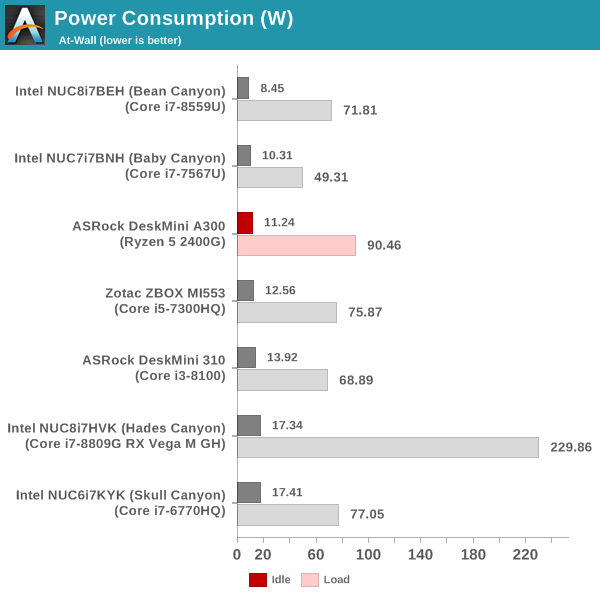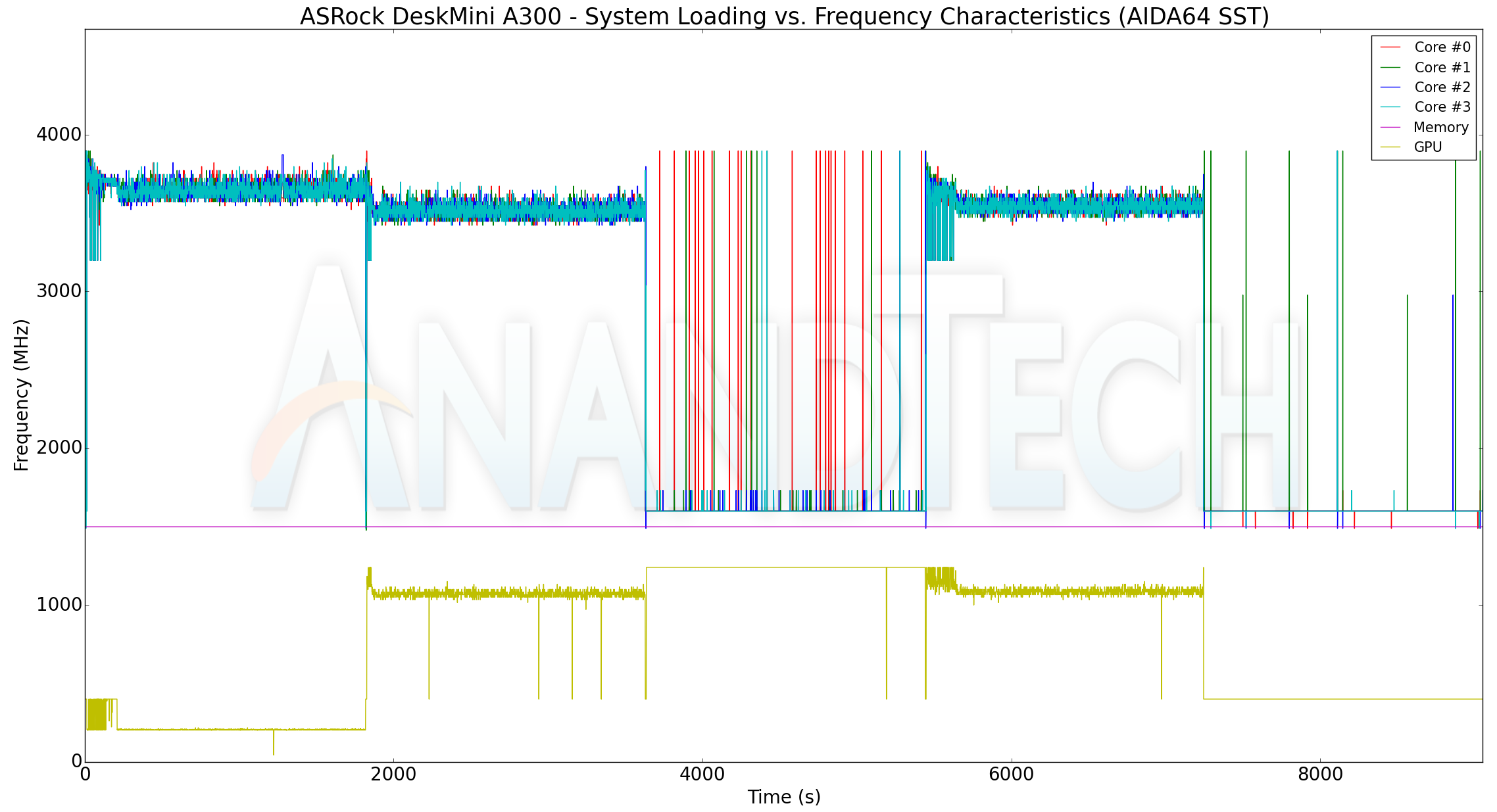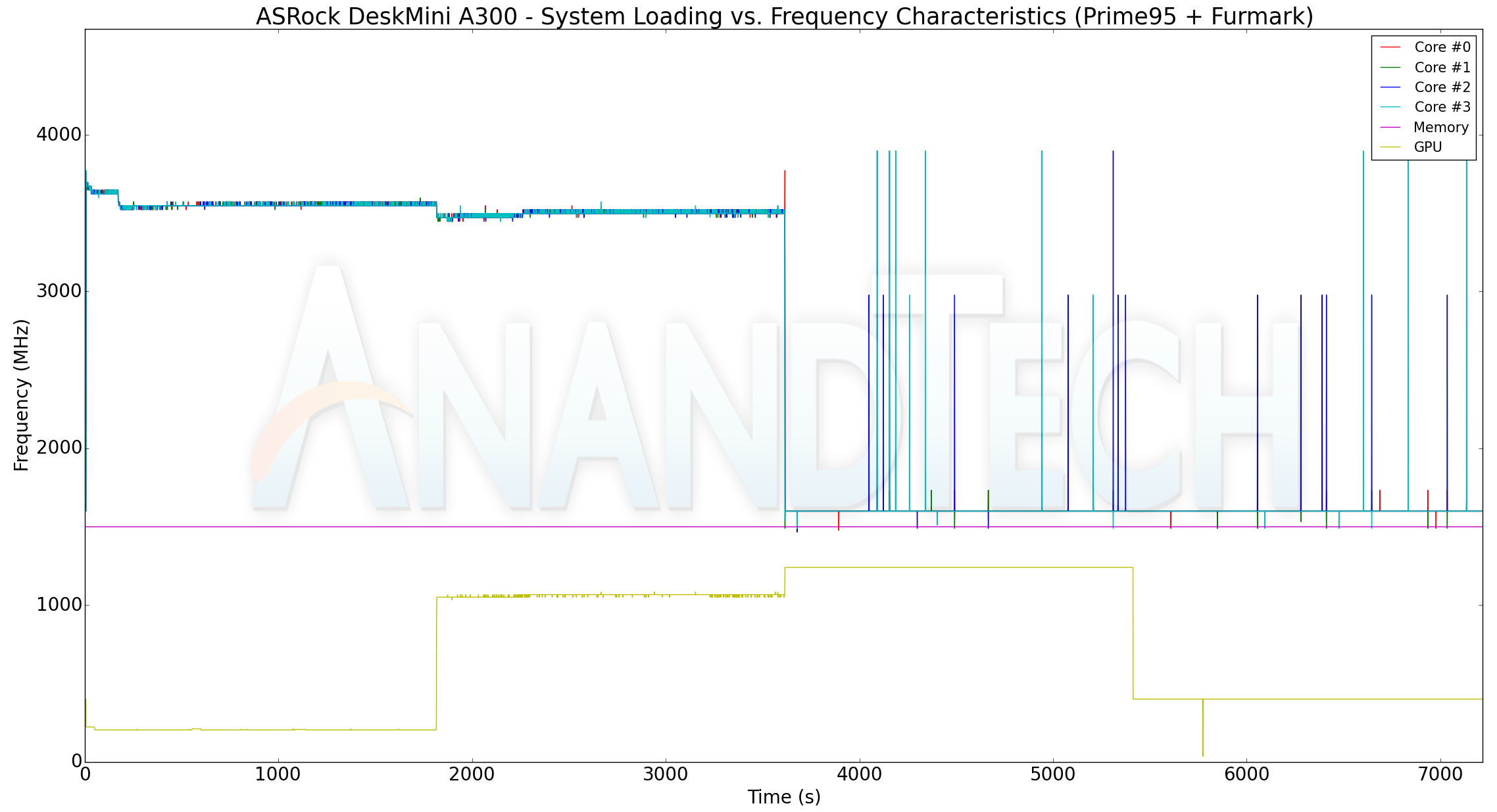The ASRock DeskMini A300 Review: An Affordable DIY AMD Ryzen mini-PC
by Ganesh T S on April 26, 2019 8:00 AM ESTPower Consumption and Thermal Performance
The power consumption at the wall was measured with a 4K display being driven through the HDMI port. In the graphs below, we compare the idle and load power of the ASRock DeskMini A300 with other SFF PCs evaluated before. For load power consumption, we ran the AIDA64 System Stability Test with various stress components, as well as a combination of Prime95 and Furmark, and noted the maximum sustained power consumption at the wall.

The key comparison here is against the DeskMini 310. Thanks to the use of a more power-efficient NVMe SSD, and the A300 PCH that essentially acts as a transparent bridge, the idle power consumption of the DeskMini A300 is a full 2W lower than the DeskMini 310. The load case, however, is completely different. We see the DeskMini A300 sustaining more than 90W at the wall. This number is higher than the load consumption of any other iGPU-only system we are comparing against.
Our thermal stress routine starts with the system at idle, followed by four stages of different system loading profiles using the AIDA64 System Stability Test (each of 30 minutes duration). In the first stage, we stress the CPU, caches and RAM. In the second stage, we add the GPU to the above list. In the third stage, we stress the GPU standalone. In the final stage, we stress all the system components (including the disks). Beyond this, we leave the unit idle in order to determine how quickly the various temperatures in the system can come back to normal idling range. The various clocks, temperatures and power consumption numbers for the system during the above routine are presented in the graphs below.
| ASRock DeskMini A300 System Loading with the AIDA64 System Stability Test | |||

At the start of our stress routine, we see most of the cores at the boost clock (3.9 GHz), but, the temperature quickly approaches 78C. The DeskMini A300 BIOS seems to treat that as the indicator to bring down the cores to the base clock of 3.6 GHz. In this initial period, the package power (labeled as reported, but, is more likely to be the power consumption of the x86 cores alone) is around 35W. That drops down to 30W after the cores go back to the base clock. After adding the GPU loading, the cores clocks do go down a bit to around 3.4 GHz (as the GPU ramps up from around 200 MHz to around 1.1 GHz). The reported package power remains constant at 30W. Unlike the reported package power, the at-wall power consumption provides hard irrefutable numbers. In the boost clock state, the wall power goes as high as 80W before settling down to around 72W. When the GPU load is added, the metric stabilizes around 85W. If the GPU alone is loaded, the core clocks jump down to 1.6 GHz, and the GPU starts running at the rated clock (1250 MHz). The at-wall consumption is around 43W. When stressing everything in the system, the added storage workload slightly bumps up the at-wall consumption by a couple of watts, but, other metrics remain similar to the second stage. The temperature of the cores never exceed 80C at any point in the AIDA64 system stability test.
We also run a custom stress test involving Prime95 and Furmark. Starting with Prime95 alone, we add Furmark to the mix after 30 minutes. After another 30 minutes of simultaneous CPU and GPU loading, we terminate the Prime95 process alone and let the GPU run at full throttle. The metrics graphed for the AIDA64 system stability test are also graphed here.
| ASRock DeskMini A300 System Loading with Prime95 and Furmark | |||

Interestingly, Prime95 doesn't trigger the boost clocks for the cores. Otherwise, the loading characteristics for the frequencies, temperature, and power are largely the same as what we observe with the AIDA64 system stability test workloads. The only thing of note is that Prime95 and Furmark together make the system consume north of 90W at the wall.
The thermal solution is very effective, ensuring that the temperatures never cross 80C while allowing the APU's CPU cores and GPU to operate at the advertised frequencies / rated power consumption. The 90W peak power consumption also indicates that the Ryzen 5 2400G is operating at its rated TDP of 65W in the DeskMini A300.










88 Comments
View All Comments
Irata - Thursday, May 2, 2019 - link
True about the system. Memory was good, but the SSD was a slower one.Basically, I would really like to see premium components being used in AMD based systems just like in Intel systems (or you could do it the other way around to reach the same price).
mikato - Thursday, May 2, 2019 - link
My price comparison cancelled out the reviewer's choices of memory and SSD. Those are things each person can choose.suraj jha - Wednesday, May 1, 2019 - link
Quickbooks online support is the best smarter business tools which resolves any issues in business accounting software. Here you may benefited by phone or post queries. https://www.quickbookspayrollonline.com/duartix - Thursday, May 2, 2019 - link
I've searched the whole article for the word "Noise" and I couldn't find a single reference. :(On a HTPC perspective, noise can be a determining factor.
How will it stack up when compared to Intel NUCs?
sor - Thursday, May 2, 2019 - link
It’s very quiet while gaming, at least if you use the wraith cooler. Much quieter than any video card (aside from fabless ones of course. Not completely inaudible but quieter than my MacBook Pro.mikato - Friday, May 3, 2019 - link
Thank you! Now that is a good comparison. I'm guessing it's quiet enough for me and my 6 foot HTPC situation. How about when not gaming? Is playing Youtube or Netflix or something basically not noticeable at all?alicetaylor - Monday, May 13, 2019 - link
great article, I was very impressed about it, wish you would have stayed next sharehttp://mutilateadoll2game.com
Dik - Sunday, July 14, 2019 - link
Will the ASRock A300 be coming out with USB 3.1 Gen 2? Can this be a BIOS upgrade? or it a feature of the chipset? I assume you can use the Rizen 3900X processor.Dik